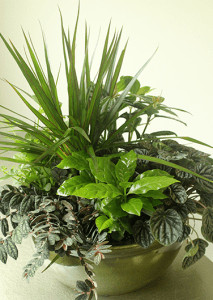[vc_row][vc_column][vc_column_text] No – you don’t have a brown thumb, and even if you do, we’re here to help you green up!
No – you don’t have a brown thumb, and even if you do, we’re here to help you green up!
Winter is probably the most vulnerable time for houseplants. By nature, the stems and leaves above the soil get their nourishment from the roots below the soil. When this process is inhibited, it affects the health of the overall plant and you will begin to notice signs of stress – hence, “the root of the problem.”
The growth period for most house plants is spring through summer and during the winter they go dormant. The secret is to adjust our winter plant care approach to help plants adapt to seasonal conditions like lower light levels, dry air, shorter days and chilly temperatures.
If your plants seem to be struggling, there are a few indicators we can look at to diagnose the problem. The most common causes of stress this time of year are:
-
-
- Under Watering
- Over Watering
- Over Fertilization
- Pot Size
-
Triage Your Plant
Take a look at these conditions to see which ones match your plant’s current condition and follow the steps to recovery!
[/vc_column_text][/vc_column][/vc_row][vc_row][vc_column][vc_column_text]
Symptom:
-
- wilting
- brown or curled leaf tips
- slow leaf growth
- translucent leaves
- premature dropping of flowers or leaves
- pests
Likely Problem:
Under Watering – too little water does not supply the plant with adequate nutrients from the water or soil.
Solution:
If extreme drought is present, place the plant in sink filled with enough tepid water to cover the entire container and do not remove until bubbles stop. Then empty the sink and allow it to drain thoroughly. Otherwise aim to check the moisture level about once a week and water when top 1-2” of soil is dry.[/vc_column_text][vc_column_text]
Symptom:
-
- brown leaves with rotten spots brown mushy or stinky roots young and old leaves falling at once
- mold or fungus on soil surface
- standing water in container
Likely Problem:
Over Watering – Too much water can suffocate the roots causing fungus or disease.
Solution:
Simply allow the soil to dry out more between watering. Test by sticking your finger in the soil and water only when dry to about 1-2” in depth. Be sure your pot is draining properly. If mold or rot is present, remove rotted leaves or stems and remove the plant from the pot. Gently remove soggy soil from roots and repot in fresh soil.[/vc_column_text][vc_column_text]
Symptom:
-
- wilting (with thorough watering)
- dropping lower leaves
- overall weak growth
- overall yellow-green color
Likely Problem:
Over Fertilization – house plants go dormant in winter and require fewer nutrients. Salt build up from fertilizer can cause root damage.
Solution:
Place the plant in the sink or tub and thoroughly flush with tepid water. Repeat as needed – allowing the plant to drain well in between. Fertilize Feb-Mar when new growth begins to show.[/vc_column_text][vc_column_text]
Symptom:
-
- soil dries out quickly
- water immediately drains from container
- Roots protrude from pot drainage holes
- mold or fungus on soil
- water pools on top of soil or in bottom of container
Likely Problem:
Pot Size – if you are properly watering and fertilizing your plants and these problems exist, your container may not be properly sized.
Solution:
Long roots need a deep container and shallow rooted plants, such as succulents, can survive well in a shallow container. If the water runs through the pot and out the bottom, instead of absorbing into the soil and roots are compacted or showing through drain holes, your pot is probably too small. If water pools or mold is present on the soil, your pot may be too large. Choose a container that is a few inches larger than the old pot or root ball. Replace soil up to the top of the root ball, covering all the roots. You can usually see a natural fill line on the plant stem when re-potting.[/vc_column_text][/vc_column][/vc_row][vc_row][vc_column][vc_column_text]
After applying the proper solution, you should start to see improvement in the health of your plant in about a week or two.
Other Winter Plant Care tips to keep in mind:
 Most houseplants are tropical and prefer temperatures between 65° F and 75° F during the day and about 10 degrees cooler at night.
Most houseplants are tropical and prefer temperatures between 65° F and 75° F during the day and about 10 degrees cooler at night.- For many plants, temperatures below 50° F can cause problems.
- Place plants in bright windows for winter. Choose windows that get the longest and brightest amount of sun per day, but avoid placing too close for leaves to touch the window or in any generally drafty area. Some plants are extra ideal for windowsills!
- If temps will dip below freezing outdoors and plants are close to the window, don’t be afraid to drape them with a light cloth for protection overnight.
- Occasionally mist plants to wash dust from their leaves, so they can make maximum use of available light.
- And remember – the easiest way to re-pot your plants is to bring them to our greenhouse and we’ll re-pot them for you!
My Pro Tip: If you have tried everything and your plant’s condition is not improving, we welcome your Winter Plant Care questions. Keep in mind, most plants are tropical in origin and they may just need more humidity than naturally occurs in your home. Try a humidifier in the same room as your plants or as an alternative, any of these common house plants will thrive in the bathroom with steam treatments from your daily showers:
Aloe Vera, Bamboo, Begonia, Boston Fern, Dieffenbachia, Dracaena, Hibiscus, Ivy, Peace Lilly, Orchids, Philodendron, Pothos, Snake Plant, Spider Plant, ZZ Plant.
Bring them in and turn your bath into a spa-like environment!

Also see our Christmas Cactus, Succulent and Poinsettia care tips.
See you at Studley’s![/vc_column_text][/vc_column][/vc_row]





Pingback: Plant Gift Guide | Studley's Flower Gardens